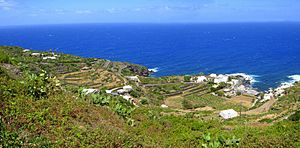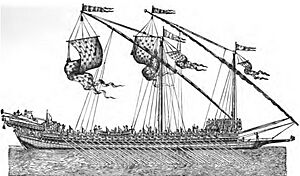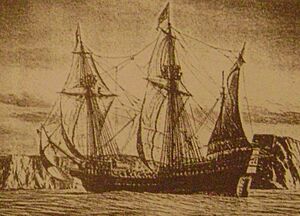Battle of Pantelleria (1586) facts for kids
Quick facts for kids Battle of Pantelleria (1586) |
|||||||
|---|---|---|---|---|---|---|---|
| Part of the Anglo–Spanish War | |||||||
 Island of Pantelleria coast: The English ships came close to shore for their protection. |
|||||||
|
|||||||
| Belligerents | |||||||
| Commanders and leaders | |||||||
| Pedro de Leyva | Edward Wilkinson | ||||||
| Strength | |||||||
| 11 galleys 2 frigates |
5 armed merchant galleons & vessels | ||||||
| Casualties and losses | |||||||
| Many galleys severely damaged, Heavy casualties |
2 killed and 15 wounded | ||||||
The Battle of Pantelleria was a sea fight that happened on July 13, 1586. It took place near the island of Pantelleria in the Mediterranean Sea. This battle was part of the Anglo-Spanish War.
In this fight, five English merchant ships from the Levant Company faced a larger fleet. The English ships were led by Edward Wilkinson. The other fleet had eleven Spanish and Maltese galleys, led by Don Pedro de Leyva. The English ships successfully fought off all attacks. They were able to return home safely.
Even though it was a smaller battle, it was very important. It showed how powerful English ships and their cannons were. This experience helped the English prepare for bigger battles. Two years later, this firepower would be used against the mighty Spanish armada.
Contents
Why the Battle Happened
Trade in the Mediterranean
The Levant Company was a group of English merchants. They started trading in the Mediterranean Sea in 1580. This happened after Queen Elizabeth I gave them permission. They set up trading posts, called "factories," in important cities. These included Aleppo, Constantinople, Alexandria, and Smyrna.
Rising Tensions with Spain
In 1585, England and Spain became enemies. Philip II of Spain decided it was time to invade England. This meant war was officially declared. Because of this, the Levant Company armed its ships. The English government helped pay for these weapons.
Spain had many warships in the Mediterranean. Two groups of galleys were sailing near the Straits of Gibraltar. Another group, the Sicilian squadron, was made of Spanish and Maltese galleys. Don Pedro de Leyva was in charge of this group. Both Spanish commanders had orders to stop any English merchant ships they found. English ships had to sail through these areas to get home.
English Ships Set Sail
Five ships from the Levant Company left London in November 1585. The Merchant Royal was the main ship. It was a 300-ton galleon and Edward Wilkinson was its acting admiral. The William and John was also going to Tripoli. The Toby was headed for Constantinople. The Susan and another 300-ton armed ship, the Edward Bonaventure, were going to Venice.
After finishing their trading, the ships met up. They gathered at Zante (now called Zakynthos). They loaded up supplies for their journey home. Then, they set sail together.
The Ships Meet
On July 13, 1586, the English ships were near Pantelleria island. This island is located between Tunis and Sicily. They soon saw many ships in the distance. These turned out to be eleven galleys and two smaller frigates.
Wilkinson, the English commander, gave an order. He told his ships to sail very close to the island's coast. This way, the Spanish ships could not surround them. Then, he told his crews to get ready for a fight. The English ships had new cannons like sakers, culverins, and demi-culverins. This battle would be their first real test at sea.
The Spanish admiral, Don Pedro de Leyva, brought his ships closer. But he did not attack right away. Instead, he sent a messenger to the Merchant Royal. The messenger asked what the English ships were doing. He also asked where they had come from. The English explained they had been trading in Turkey. They were now returning home to England.
De Leyva then demanded that the English ships show loyalty to the Spanish king. Wilkinson flatly refused this demand. After more refusals, De Leyva gave an ultimatum. He said the English ships would either be sunk or taken to a Spanish port. Wilkinson refused again. Both fleets then got ready for battle.
The Battle Begins
The Spanish admiral's galley fired the first shot. The Merchant Royal quickly fired back with a culverin cannon. The battle had begun. Each English ship faced two Spanish galleys. The fighting became very fierce. The Spanish galleys tried to get close enough to board the English ships. Boarding was the main way galleys fought.
However, the English ships kept firing their cannons steadily. They had powerful twenty-pounder culverins. Each ship had four of these. They also had ten twelve-pounder demi-culverins. For short-range attacks, they used perriers. These cannons were very accurate and caused a lot of damage from a distance.
The Spanish and Maltese galleys could not get close enough. Their big fifty-pounder guns were mounted in the middle of their ships. They could not use them without getting badly damaged themselves. One galley did manage to get close. It bravely fired two shots. These shots caused the only English injuries on the Susan. But the Susan's guns soon forced that galley away.
The William and John almost got into trouble. It briefly touched the bottom in the shallow water. This happened as the ships were sailing close to the shore. But the wind was strong enough to push it forward to safety.
Soon, Don Pedro de Leyva realized his attack was failing. His galleys and frigates were getting much more damage. The English ships were hardly hurt at all. Even de Leyva's own flag galley was badly damaged. It had to pull away from the fight. After a few more hours of fighting, the rest of the Spanish ships also retreated. Most of them were damaged. Some were struggling to stay afloat. The English ships slowly moved away from the coast. They stayed in their convoy formation and headed west.
After the Fight
The battle lasted for almost five hours. When it ended, the Spanish galleys quickly went to the nearest port in Sicily for repairs. Leyva had to tie three of his badly damaged galleys together. This included his own ship. He did this to keep them from sinking.
The English ships checked their losses after fighting off the Spanish. They found very little damage. Only two English sailors were killed. Fifteen were wounded, mostly from the Susan. None of their ships had serious damage. They stopped in Algiers for supplies. Then, they successfully sailed through another group of Spanish galleys. These galleys were waiting for them in the Straits of Gibraltar. No fight happened there. The English ships sailed through with the help of a thick mist. When the galleys finally saw them, they tried to catch up, but it was too late.
The English ships returned home safely. News of the battle soon reached Cairo. Levant Company members were meeting there to discuss trade. They were first alarmed by the news. But then they were very happy with the results. Learning from the battle, they decided to use the same fighting strategy for all future trading missions.
The Levant Company now knew how to sail in dangerous waters. This was especially true in the Strait of Gibraltar. In 1590, the Spanish tried to attack the same company ships again. But they were fought off in the Battle of the Strait of Gibraltar. The same thing happened again almost a year later in 1591. Because of these battles, the Royal Navy often used Levant Company ships. These fights were a big test for future warships. They also showed that the old war galley was becoming less useful.
See also
Images for kids





